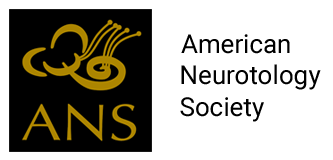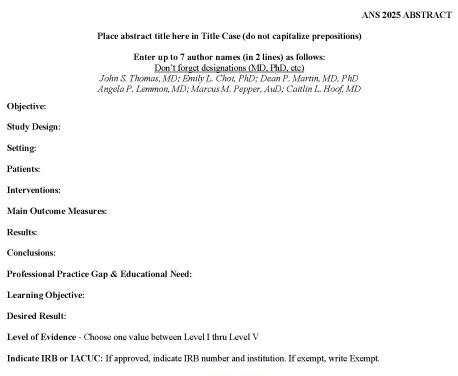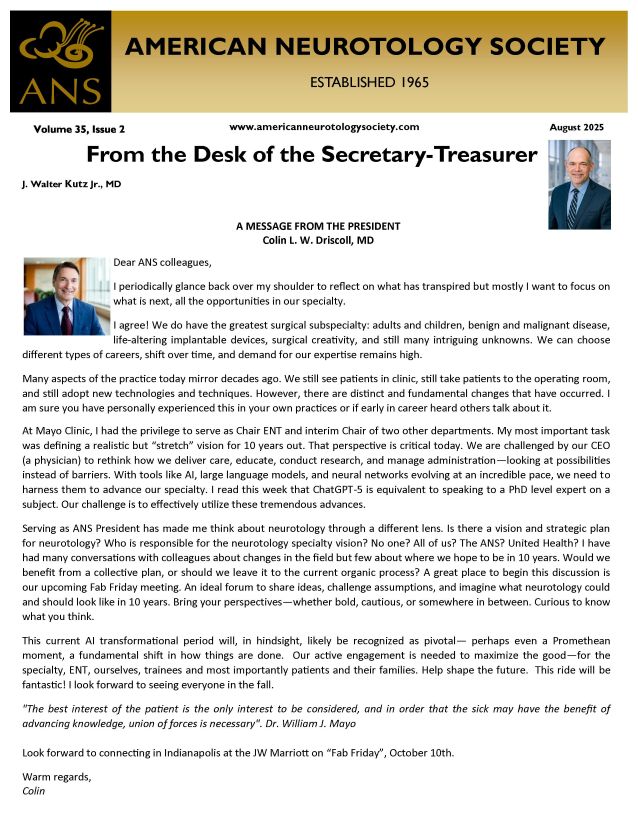ANS ABSTRACT SUBMISSION INSTRUCTIONS 2025AMERICAN NEUROTOLOGY SOCIETY ABSTRACTS ACCEPTED from September 1 - October 15, 2024 (11:59 PM PT) Abstract Submission Instructions: VERY IMPORTANT - Please read all instructions carefully before you begin your submission. Click here to print a hard copy of the following instructions. Please contact Kristen Bordignon or Cheryl Bradley, ANS Administrative team, if you have any questions prior to submitting your abstract. The American Neurotology Society accepts on-line submission of abstracts only. Failure to comply with the instructions will disqualify your abstract submission. Email: [email protected] Please note if you are not a member of the American Neurotology Society you will be required to create a username (email) and a password before you begin your abstract submission. If you created a profile in the past, use the same log in (your email address). Members may access the form when logged in. You must indicate ONE of the following before submitting your abstract form.
The preferred method of presentation (ORAL or POSTER) should be noted. If you select EITHER, the ANS Scientific Program Committee will make the final determination as to where to place your abstract based on the final AB score. The same submission rules apply for both POSTER and ORAL submissions. The ANS abstracts are scored based on scientific merit, historically between 65-70% of abstracts are accepted. Please follow instructions to ensure you submit the best possible abstract. Acknowledgment of receipt of an electronic abstract submission will be sent to the primary author via email from the ANS website default email, [email protected] with subject line ANS 2025 Abstract Form Submitted Successfully. If you do not receive an email acknowledgement, first check your SPAM and if it's not there, we did not receive your abstract. Please contact the ANS Administrator at [email protected] for assistance before the deadline. IMPORTANT!!! YOUR ABSTRACT MUST BE SUBMITTED ON THE ANS TEMPLATE (IN MICROSOFT OFFICE WORD, no PDF) AND ATTACHED TO THE ABSTRACT SUBMISSION FORM. CLICK HERE TO DOWNLOAD & SAVE THE WORD DOCUMENT TEMPLATE SO YOU CAN PREPARE YOUR ABSTRACT IN ADVANCE AND HAVE IT READY TO UPLOAD WHEN YOU COMPLETE THE SUBMISSION FORM. Abstracts must be structured according to Otology & Neurotology Guidelines for Authors. Follow these guidelines when preparing your abstract. General Format: A concise abstract of not more than 275 words or less is required for all original clinical and basic science contributions, including review articles. These should be organized according to the headings outlined below. The author(s) must accept sole responsibility for statements in their submitted abstract. The 275-word count is for the body of the abstract only, not headings or other required elements, however, the entire document is limited to one page. (see format details). The ANS Scientific Program Committee reviews all abstracts blinded to author; please do not place any identifying information in the body of the abstract or title, such as referral to authorship or institution. Choose an appropriate title (USE OF TRADE NAMES IS PERMITTED ONLY WHEN A GENERIC TERM IS NOT AVAILABLE OR APPROPRIATE FOR THE PAPER) reflecting the content of the abstract body, as this title will appear in all publications if chosen for presentation. Do not capitalize prepositions, a, an, the, etc. Please do not enter abstract or headings in all upper case or in quotation marks. Use same format for the body of the abstract. (Times New Roman, Font size 11, use narrow margins at .5, and “justify” text where possible) Do not include the author or institution’s name(s) in the abstract title or body. List all authors in proper sequence, with the primary/presenter FIRST (limited to seven individuals including primary author) using first names, middle initials, and last names and exact designations (i.e. MD, PhD, MS, etc. for publication purposes). We assume the primary (first) author is the presenter, however, if the primary author is not the presenter, you must name which author is the presenter at the time of submission. On the abstract form, you will also be asked to provide an email address for an additional author. If you also have a corresponding author different than the primary author, please indicate this on the abstract form. Correspondence will be sent to both the primary and the corresponding author. MANUSCRIPTS: The American Neurotology Society requires a completed manuscript be sent electronically to the Otology & Neurotology Journal one month before the scientific program. This year's manuscript deadline will be April 18, 2025. *Primary authors of ANS ORAL presentations must comply with the manuscript requirement; this is optional for ANS Poster presentations. Members of the ANS Scientific Program Committee, the ANS Education Committee or the ANS Executive Council may be asked to review the manuscript for any commercial bias, conflict of interest, use of commercial names and any other identifying information that may conflict with the ACCME requirements. ANS reserves the right to ask you to revise, modify or amend the submitted manuscript/presentation to ensure compliance with the ACCME requirements. If you fail to comply or meet the deadline, your presentation will be withdrawn from the Scientific Program. In order to complete Part I of the ANS Abstract submission process, the Primary author must complete the Conflict of Interest/Disclosure form electronically through the ANS website/SurveyMonkey® link. As the Primary author, please complete the Conflict of Interest/Disclosure form as it relates to your presentation as the primary author. If you are not the presenter, you will be asked to complete COI/DISCLOSURE information for the presenter as well. Co-authors (non-speaking roles) are NOT REQUIRED to fill out a COI/DISCLOSURE form. If you have any questions about the manner in which to do this, please contact Kristen Bordignon before you begin. All of the statements on the COI form require an answer from the primary author at the time of submission. This is an ACCME requirement. Upon successful completion of the COI Disclosure form, you will be directly linked to the ANS website and Abstract Submission page. Be prepared to log in or create a user profile and submit your abstract at this time. YOU MAY NOT BYPASS THE COI/DISCLOSURE TO ACCESS THE ABSTRACT FORM! As the primary author, it is your responsibility to comply with the COI Disclosure guidelines. Once you begin the abstract submission process, please be prepared to complete it in its entirety, you cannot return to an incomplete form, unfortunately, you will have to start over. CLICK HERE or copy and paste the link below to begin the abstract submission process beginning with the mandatory Conflict of Interest/Disclosure form. https://www.surveymonkey.com/r/ANSAbstract2025COIform Disclosure will be stated in the scientific program and verbally from the podium via the first slide of the presentation. If you do not have anything to disclose, you must indicate this on the online form. The disclosure information you provide will not influence the review of your abstract. If your presentation describes the use of a device, product, or drug that is not FDA approved or the off-label use of an approved device, product, or drug or unapproved usage, it is your responsibility to disclose this information verbally to the learner during your presentation. The intent of this policy is not to discourage speakers who have relationships with commercial entities from presenting, but to identify these relationships to the listeners so that they may form their own judgments. Failure to disclose this information on submission forms, will result in disqualification of your abstract. REMINDER: YOU MUST USE THE ABSTRACT WORD DOC TEMPLATE WHEN PREPARING YOUR ABSTRACT. THIS DOCUMENT WILL BE VIEWED AND SCORED BY THE ANS SCIENTIFIC PROGRAM COMMITTEE. LOOK FOR SPELLING & FORMATTING ERRORS BEFORE SUBMITTING. BE SURE TO TURN OFF TRACK CHANGES. DUE TO TIME CONSTRAINTS, WE ARE NOT SWAPPING ABSTRACTS IF YOU HAVE LEFT SOMETHING OUT OR DISCOVER MISSPELLINGS. For clinical studies: For basic science reports: For reviews and meta-analysis: ABSTRACT SUBMISSION FORM - WHAT YOU NEED TO KNOWThe abstract form will include the following questions, please be prepared to answer each question/item. It is imperative that both the Abstract title and Primary author name is an identical match on both the Disclosure form and the Abstract Submission page. (THERE WILL BE NO CHANGES ACCEPTED AFTER 10/15/2024) YOU WILL LED DIRECTLY TO THE ANS WEBSITE ABSTRACT SUBMISSION FORM UPON COMPLETION OF THE COI DISCLOSURE. TITLE OF ABSTRACT - (USE OF TRADE NAMES IS PERMITTED ONLY WHEN A GENERIC TERM IS NOT AVAILABLE OR APPROPRIATE FOR THE PAPER) Capitalize the first letter of each word in the title, (not prepositions); please do not enter information in all upper case or in quotation marks. Use same format for the body of the abstract. Do not include the author's name(s). AUTHORS - List all authors in proper sequence, (primary first and up to 6 more for a total of 7 max) using FIRST NAMES, MIDDLE INITIALS, and LAST NAMES AND EXACT DESIGNATIONS (i.e. MD, PhD, etc…) AS THEY WOULD BE PUBLISHED. (LIST format please) NAME, ADDRESS, TELEPHONE, E-MAIL OF PRIMARY AUTHOR: NAME, ADDRESS, TELEPHONE, E-MAIL OF PRESENTER AT COSM IF OTHER THAN THE PRIMARY AUTHOR: ABSTRACT – YOU MUST SAVE THE ANS WORD DOC TEMPLATE FOR YOUR ABSTRACT AND ATTACH THE WORD DOCUMENT TO YOUR ABSTRACT SUBMISSION FORM. Save as ANS 2025 Abstract with your last name and a couple words from the title. (DO NOT SAVE AS A PDF)
ABSTRACT EXAMPLE OF FORMATTING IDENTIFICATION OF PROFESSIONAL PRACTICE GAPS, LEARNING OBJECTIVES, & DESIRED RESULTS ARE REQUIRED ON YOUR WORD DOCUMENT. THE DEFINITION OF EACH TERM MAY BE FOUND BELOW.
If you would like your abstract to be considered for an AWARD - on the abstract form, choose from the following: NEUROTOLOGY FELLOW AWARD The Michael E. Glasscock Scientific Merit Award will be awarded to the author with the highest scoring blinded abstract submitted for the annual Spring meeting. LEVEL OF EVIDENCE - Levels of Evidence by Sackett* (RCT = Randomized Controlled Trial)
*Adapted from Sackett DL. Rules of evidence and clinical recommendations on the use of antithrombotic agents. Chest 1989; 95:2S–4S *For All Human and/or Animal Studies: OUT of USA SUBMISSIONS: APPROVAL MUST BE OBTAINED & NOTED from the appropriate ethical entity at the time of submission. *Failure to comply will result in disqualification of your abstract. State Yes or No if this abstract is under consideration for or denied publication and/or presented at any other Scientific meeting: COPYRIGHT TRANSMITTAL: Abstracts are received with the understanding that they are not under simultaneous consideration by another publication and that they are original contributions that have not been previously published. Accepted abstracts become the permanent property of Otology & Neurotology and may not be published elsewhere without permission from Otology & Neurotology* PUBLICATION STATEMENT: The material in this abstract must not have been published or presented previously at another national or international meeting and may not be under consideration for presentation at another national or international meeting including another COSM society. The study detailed in this abstract may be submitted for consideration for publication to Otology & Neurotology at any time after this call for papers begins. However, should the abstract be selected as a poster or an oral presentation, publication of the manuscript will be delayed until after the 2025 COSM meeting takes place. If this policy is violated, the ANS will prohibit presentation at the COSM meeting and the manuscript will be withdrawn from publication in print or online. The penalty for any duplicate presentation/publication is prohibition of the author from presenting at a COSM society meeting for up to three years. Duplicate submission to AOS or another participating COSM Society will disqualify your abstract immediately. Electronic signature indicates author will abide by the above Copyright and Publication statements. That concludes the abstract form instructions. The ANS Scientific Program Committee will not consider abstracts that do not contain all the required elements. In summary, please review all instructions carefully. Failure to comply with the instructions could disqualify your abstract submission. Abstracts published, presented previously or considered for presentation at another national or international meeting may not be submitted. Duplicate submissions to more than one Society will disqualify your abstract immediately. ANS 2025 Scientific Program Committee J. Thomas Roland, Jr., MD, ANS President, Chair Syed F. Ahsan, MD Kristen Bordignon, ANS Administrator
|



